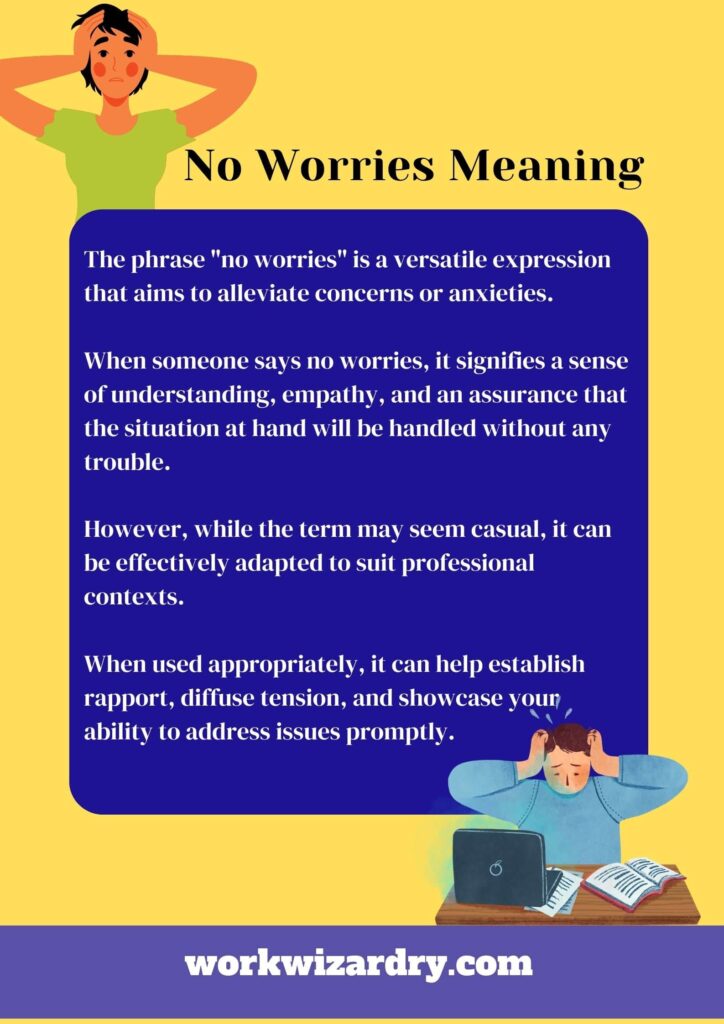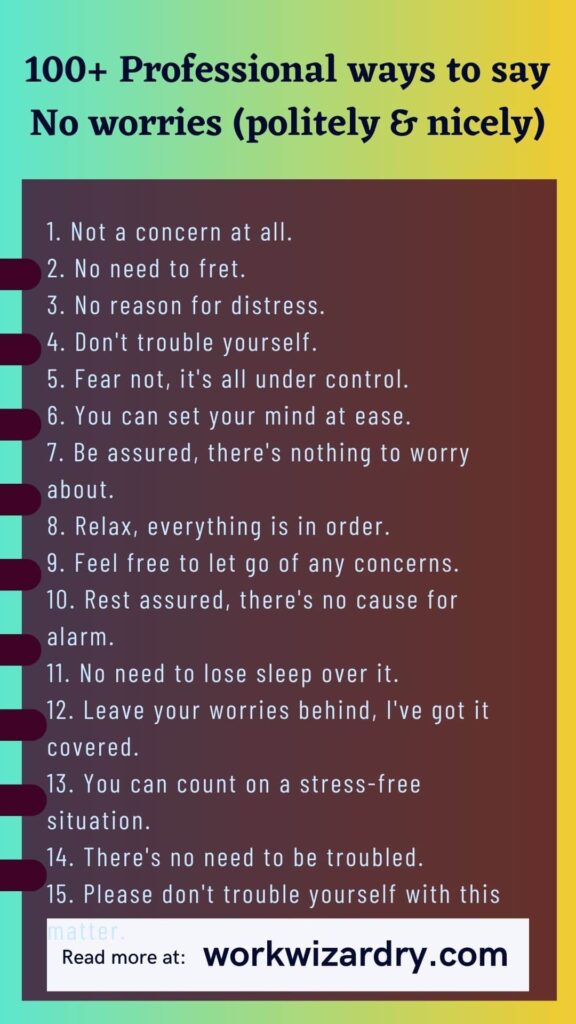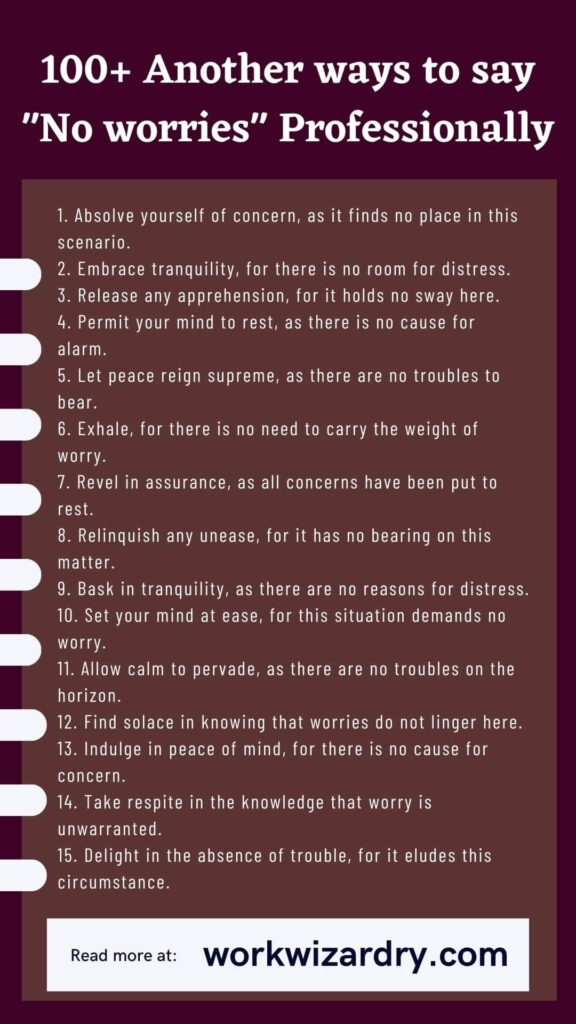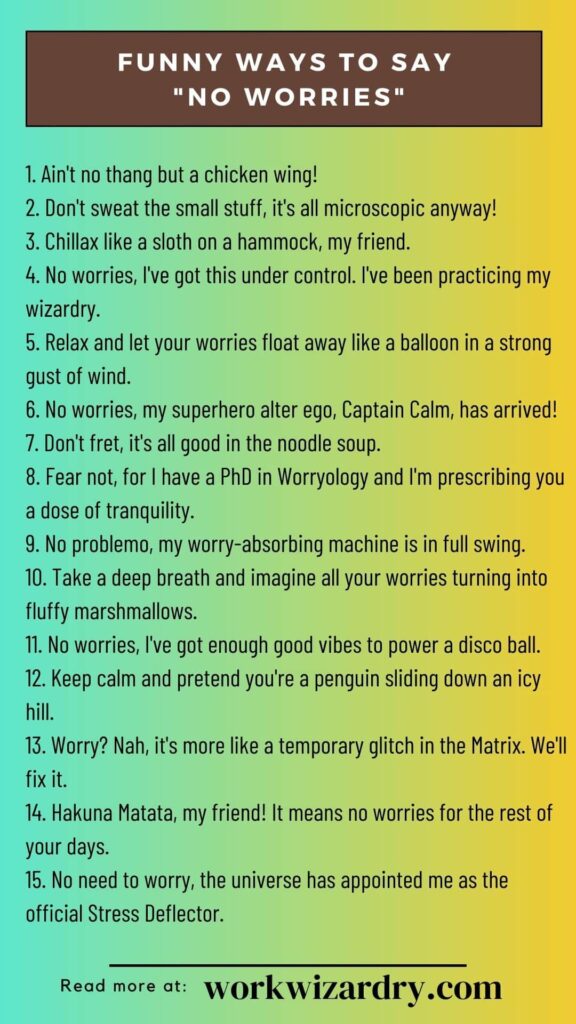In our fast-paced professional lives, effective communication is crucial.
Whether you’re engaging with colleagues, clients, or even friends, finding the right words to express yourself respectfully can be a challenging task. One common phrase that often comes to our rescue in various situations is “no worries.”
This simple yet powerful expression can convey understanding, reassurance, and a positive attitude.
However, it’s important to consider the context and your audience when using this phrase professionally.
In this blog post, we’ll explore How to say no worries professionally, the meaning of “no worries,” when to use it, and over a hundred professional ways to say no worries with examples and tips.
Additionally, we’ll delve into alternative expressions, funny ways to say no worries, and discuss appropriate responses to someone saying “no worries.”
By the end, you’ll be equipped with the knowledge to confidently navigate any professional setting while maintaining respect and courtesy.
Table of Contents

No worries meaning
The phrase “No worries” can be interpreted as a reassurance or a way to ease concerns.
Fear not, for there is no need to harbor distress or anxiety. The phrase “No worries” serves as a comforting reassurance, assuring one that there is no cause for concern or unease.
It embodies a sentiment of tranquility, aiming to alleviate any apprehensions that may have arisen.
Thus, it serves as a gentle reminder that there is no reason to fret or be troubled, as the situation at hand can be managed with ease and peace of mind.
Also read: How to professionally say don’t talk to me like that and don’t be rude? (35+ Examples and tips)
What does it mean when someone say no worries?
The phrase “no worries” is a versatile expression that aims to alleviate concerns or anxieties.
When someone says no worries, it signifies a sense of understanding, empathy, and an assurance that the situation at hand will be handled without any trouble.
However, while the term may seem casual, it can be effectively adapted to suit professional contexts.
When used appropriately, it can help establish rapport, diffuse tension, and showcase your ability to address issues promptly.
Also read: How to say I forgot professionally? at workplace or in email (80+ Examples and tips)
When to say no worries?
When someone says no worries? The phrase “no worries or Don’t worry” is typically used in informal situations to reassure someone that there is no need for concern or stress. It is commonly employed to convey a relaxed and easygoing attitude.
However, in more formal or professional settings, it may be more appropriate to express this sentiment in a different manner.
In such contexts, a more professional and respectful response could be:
- “I acknowledge your hesitation, but please be assured that there is no cause for concern. I will diligently address the issue at hand and ensure that it is resolved in a manner that aligns with our professional standards.”
This response demonstrates empathy towards the person expressing concern, while emphasizing a commitment to handling the situation professionally and effectively.

What is a professional way to say no worries?
In professional settings, it is important to communicate in a respectful and courteous manner. When responding to someone’s concern or request, there are several ways to convey the sentiment of “no worries” while maintaining a professional tone. Here are a few tips and suggestions:
1. Acknowledge the concern:
Begin your response by acknowledging the concern or request. This shows that you have understood their perspective and are actively addressing their needs.
For example:
- “I appreciate your concern and would like to address it.”
- “Thank you for bringing this to my attention. I understand your request and will provide an appropriate response.”
2. Provide reassurance:
Assure the person that their concern is valid and that you will take appropriate action. This helps build trust and demonstrates your commitment to resolving the issue.
For instance:
- “Rest assured, I will look into this matter and take the necessary steps to address it.”
- “I understand your worry, and I assure you that I will handle this situation appropriately.”
3. Offer an alternative solution or explanation:
If the initial request cannot be accommodated, provide a clear and respectful explanation, along with alternative options if applicable. This demonstrates your willingness to find a satisfactory resolution.
For example:
- “While I am unable to fulfill your specific request, I can offer an alternative solution that might meet your needs.”
- “I regret to inform you that we are unable to proceed with your initial request due to [reason]. However, I would like to suggest an alternative approach that might be suitable.”
4. Express gratitude and willingness to assist:
End your response on a positive note by expressing gratitude for their understanding and offering further assistance if needed. This conveys professionalism and leaves the door open for future collaboration.
For instance:
- “Thank you for your understanding in this matter. If you have any further concerns or require additional assistance, please do not hesitate to reach out.”
- “I appreciate your cooperation and patience. Should you require any further support, please feel free to let me know.”
Remember, the key is to strike a balance between professionalism and approachability.
Also read: How to professionally say Are you Stupid? (50+ Examples)
How to say no worries professionally?
How to professionally say no worries? Mastering the art of saying “no worries” professionally can significantly enhance our communication skills and build stronger relationships in the workplace and beyond.
By adopting a thoughtful and respectful approach, we can navigate challenging situations while maintaining a positive and supportive atmosphere.
Firstly, understanding the context and intent behind the phrase is crucial.
“No worries” should be used as a reassurance, conveying understanding and empathy, rather than dismissing or trivializing concerns.
By acknowledging the other person’s perspective and offering genuine support, we can establish trust and foster a collaborative environment.
Secondly, using alternative phrases and expressions can add depth and sincerity to our response.
Tailoring our language to match the situation, such as “I understand your concerns” or “I’ll make sure to address this promptly,” demonstrates active listening and a commitment to finding solutions.
Furthermore, non-verbal cues and body language play a significant role in delivering the message effectively.
Maintaining eye contact, using an empathetic tone, and offering a reassuring smile can all contribute to a more professional and compassionate interaction.
Lastly, following up on our commitments is essential in building credibility and maintaining professional relationships.
By taking appropriate action or providing updates, we demonstrate reliability and a genuine interest in resolving any issues.
By implementing these strategies, we can navigate difficult conversations with grace, empathy, and professionalism.
Saying “no worries” professionally is not about dismissing concerns, but rather about addressing them with understanding and providing reassurance.
Ultimately, by fostering a culture of open communication and support, we can build stronger connections, enhance productivity, and create a more positive work environment.
What not to say:
1. “No big deal” – This phrase can come across as dismissive and may downplay the other person’s concerns.
2. “Don’t worry about it” – While this phrase is commonly used, it can sound too casual or nonchalant in a professional setting.
3. “It’s fine” – Although it may seem harmless, this phrase might be interpreted as indifference or lack of concern.
What to say:
1. “Thank you for your concern, but it’s not an issue.” – This response acknowledges the person’s consideration while assuring them that there is no problem.
2. “I appreciate your apology, but there’s no need to worry.” – This phrase expresses gratitude for their apology and reassures them that their concern is unnecessary.
3. “I understand, but it’s not a problem. Thank you.” – This statement demonstrates empathy towards their worry while indicating that there is no issue.
4. “I understand your concern, but rest assured, it’s not a problem.” – This response acknowledges their worry and provides reassurance that there is no issue.
5. “Thank you for bringing it up, but there’s no need to be concerned. Everything is under control.” – This statement expresses appreciation for their attention to the matter while confidently assuring them that the situation is well-managed.
Remember, it is crucial to adapt your language and tone to the specific professional context and relationship with the person you are addressing.
The provided phrases aim to convey a respectful and professional response while alleviating any worries or concerns.
Also read: How to say I don’t know professionally? 300 Examples and tips for different situations

100+ Professional way to say no worries
The following are some Better way to say no worries professionally:
1. Not a concern at all.
2. No need to fret.
3. No reason for distress.
4. Don’t trouble yourself.
5. Fear not, it’s all under control.
6. You can set your mind at ease.
7. Be assured, there’s nothing to worry about.
8. Relax, everything is in order.
9. Feel free to let go of any concerns.
10. Rest assured, there’s no cause for alarm.
11. No need to lose sleep over it.
12. Leave your worries behind, I’ve got it covered.
13. You can count on a stress-free situation.
14. There’s no need to be troubled.
15. Please don’t trouble yourself with this matter.

Other ways to say no worries
Here are a few other ways to say no worries:
16. Let tranquility reign, for there is no cause for concern.
17. Allow your mind to be at peace, as all is well.
18. Rest assured, this matter is devoid of any trouble.
19. Be at ease, for there is no need to be troubled.
20. Cast away any apprehension, for it holds no place here.
21. Fear not, as the path ahead is free from worry.
22. Grant yourself serenity, for there are no concerns to bear.
23. May tranquility embrace you, for there is nothing to fret about.
24. Release any distress, for it has no foothold in this situation.
25. Lay your worries to rest, as they find no relevance here.
Also read: How to say I don’t agree professionally and say no politely? (100+ Examples)

Another way to say no worries professionally
The following are some another way to say no worries professionally:
26. Absolve yourself of concern, as it finds no place in this scenario.
27. Embrace tranquility, for there is no room for distress.
28. Release any apprehension, for it holds no sway here.
29. Permit your mind to rest, as there is no cause for alarm.
30. Let peace reign supreme, as there are no troubles to bear.
31. Exhale, for there is no need to carry the weight of worry.
32. Revel in assurance, as all concerns have been put to rest.
33. Relinquish any unease, for it has no bearing on this matter.
34. Bask in tranquility, as there are no reasons for distress.
35. Set your mind at ease, for this situation demands no worry.
36. Allow calm to pervade, as there are no troubles on the horizon.
37. Find solace in knowing that worries do not linger here.
38. Indulge in peace of mind, for there is no cause for concern.
39. Take respite in the knowledge that worry is unwarranted.
40. Delight in the absence of trouble, for it eludes this circumstance.
Few more examples on How to professionally say no worries
Here are some more examples on How to say no worries in formal way, politely and professionally:
41. Embrace the serenity that accompanies a worry-free state.
42. Luxuriate in the calm waters, where worries cease to exist.
43. Savor the tranquility that defines this situation.
44. Be at ease, as there are no shadows of concern here.
45. Revel in the grace of a worry-free environment.
46. Rest assured, for there is no need to be burdened by worry.
47. Find solace in the gentle breeze that sweeps away all worries.
48. Allow yourself the luxury of a worry-free mindset.
49. Rejoice in the absence of worry, for it has been banished.
50. Let peace be your companion, for worries have been vanquished.
Also read: 275+ Examples on how to disagree politely phrases in a respectful way

Funny way to say no worries
These are a few funny ways to say no worries in a nice way:
1. Ain’t no thang but a chicken wing!
2. Don’t sweat the small stuff, it’s all microscopic anyway!
3. Chillax like a sloth on a hammock, my friend.
4. No worries, I’ve got this under control. I’ve been practicing my wizardry.
5. Relax and let your worries float away like a balloon in a strong gust of wind.
6. No worries, my superhero alter ego, Captain Calm, has arrived!
7. Don’t fret, it’s all good in the noodle soup.
8. Fear not, for I have a PhD in Worryology and I’m prescribing you a dose of tranquility.
9. No problemo, my worry-absorbing machine is in full swing.
10. Take a deep breath and imagine all your worries turning into fluffy marshmallows.
11. No worries, I’ve got enough good vibes to power a disco ball.
12. Keep calm and pretend you’re a penguin sliding down an icy hill.
13. Worry? Nah, it’s more like a temporary glitch in the Matrix. We’ll fix it.
14. Hakuna Matata, my friend! It means no worries for the rest of your days.
15. No need to worry, the universe has appointed me as the official Stress Deflector.
What to say instead of no worries?
Instead of saying “no worries,” you can use the following No worries alternative phrases in a professional and respectful manner:
1. “Not a problem.”
2. “Certainly, I’ll take care of it.”
3. “I’ll handle that for you.”
4. “You can count on me.”
5. “Consider it done.”
6. “I’ll ensure everything is taken care of.”
7. “I’ll make sure there are no issues.”
8. “Rest assured, I’ll see to it.”
9. “You needn’t worry; I’ll manage it.”
10. “I understand your concern, and I’ll address it.”
These alternatives convey a sense of responsibility, reassurance, and professionalism while maintaining a respectful tone.
Is it polite to say no worries?
Certainly! In professional and workplace communication, it is considered acceptable and courteous to use the phrase “no worries” to convey reassurance or to dismiss any concerns.
This phrase is commonly used in informal or casual settings to indicate that there is no need for concern or apologies.
However, in more formal or professional contexts, it is advisable to opt for alternative phrases that maintain a respectful tone while achieving the same purpose.
Examples of such phrases include:
- “Please don’t fret about it.”
- “There’s no need to be concerned.”
- “Rest assured, it’s not an issue.”
- “You needn’t worry about that.”
- “No need to apologize, everything is fine.”
These alternatives convey a similar sentiment to “no worries” in a more formal and respectful manner, ensuring clear and professional communication.
How to say no worries in different ways?
If you are wondering How to say don’t worry professionally, here some more No worries synonym professional phrases and examples sentences you can use:
1. No apologies necessary, I understand.
2. I will make sure it is completed.
3. It’s my pleasure to be of help.
4. Absolutely, I can make that happen.
5. I am happy to assist you in any way.
6. Please don’t worry, everything is under control.
7. It’s not a significant issue, don’t worry about it.
8. Certainly, it will be my utmost priority to provide you with that.
9. You can count on me to get it done.
10. Be at ease, as it has already been addressed.
11. You need not fret, as there is no sweat.
12. It is unnecessary to extend apologies, as it is an insignificant matter.
13. Don’t stress about it, it’s taken care of.
14. It is of no great consequence, please do not concern yourself.
15. Don’t be stressed, without a doubt, it shall be done.
16. Absolutely, I am at your service.
17. Without question, it is guaranteed.
18. Be assured that it will be accomplished.
19. You can relax, I have already handled it.
20. Let me take care of it for you.
21. Certainly, I am happy to help.
22. Absolutely, consider it done.
23. I am glad to be of assistance to you.
24. It would be my pleasure to help you.
How to say no worries professionally in email?
Here are some examples and free templates you can use on how to say no worries professionally in email:
Subject: Reassurance and Understanding
Dear [Recipient’s Name],
I hope this email finds you well. I wanted to address the concerns you raised and assure you that there is no need to worry. Your feedback and questions are valuable to us, and we appreciate your attention to detail. Please allow me to provide you with a comprehensive response that will put your mind at ease.
1. Rest assured:
I want to assure you that we have thoroughly examined the matter you mentioned, and we are taking the necessary steps to address it promptly.
Our dedicated team is actively working towards a resolution, and we will keep you informed of any updates.
2. Full confidence:
I have full confidence in our team’s ability to handle this situation. We understand the importance of your concerns and are committed to finding a satisfactory solution.
Please be assured that we are giving it the utmost attention and priority.
3. Complete peace of mind:
I want to emphasize that you can have complete peace of mind regarding this matter.
Our company has a strong track record of resolving similar issues efficiently and effectively. We will spare no effort in ensuring that your concerns are properly addressed.
4. Your satisfaction matters:
Your satisfaction is of paramount importance to us, and we are committed to exceeding your expectations.
I assure you that we are dedicated to providing the highest level of service and support, and we will do everything within our power to ensure a positive outcome.
5. Trust in our expertise:
I understand that this situation may have caused some uneasiness, but I would like to remind you of our expertise in handling such matters.
We have a proven track record in delivering successful outcomes and maintaining strong relationships with our valued clients.
Your trust is greatly appreciated, and we will do everything possible to maintain it.
Once again, I want to emphasize that your concerns are being taken seriously, and we are committed to resolving them to your satisfaction. If you have any further questions or require additional information, please do not hesitate to reach out to me directly.
Thank you for your understanding and patience.
Best regards,
[Your Name]
[Your Position/Title]
[Your Company/Organization]
What to say when someone says no worries?
If you are wondering what to reply when someone says no worries? Here are some example sentences you can use:
1. Your tranquility in this matter is truly refreshing.
2. I admire your ability to handle situations with such grace.
3. Your nonchalant attitude puts my mind at ease, thank you.
4. Your unwavering composure is admirable and sets a great example.
5. I’m grateful for your understanding and the peace of mind it brings.
6. Your calm demeanor is like a breath of fresh air amidst the chaos.
7. Your graciousness in this situation speaks volumes about your character.
8. Your reassuring words have brought a sense of serenity to the situation.
9. Your ability to remain unruffled is truly impressive.
10. I’m thankful for your composed response that puts any concerns to rest.
11. Your tranquil disposition is a testament to your professionalism.
12. Your carefree response has lifted a weight off my shoulders, thank you.
13. Your poise and confidence in handling this matter is commendable.
14. I appreciate your untroubled approach, it reflects your expertise.
15. Your relaxed response has granted me a sense of relief, and I’m grateful.
16. Thank you for being so understanding.
17. I appreciate your reassurance.
18. I’m glad to hear that it’s not a problem.
19. Your understanding is greatly appreciated.
20. I’m grateful for your flexibility.
21. That’s a relief, thank you.
22. I’m glad you’re not concerned about it.
23. Your calmness is reassuring, thank you.
24. I’m grateful for your easy-going attitude.
25. I appreciate your willingness to accommodate.
Conclusion:
In conclusion, mastering the art of saying “no worries” professionally is a valuable skill that can enhance our communication and relationships in various settings.
By adopting a calm and reassuring tone, acknowledging the concern or request, and offering alternative solutions or suggestions, we can convey our understanding and empathy while maintaining a professional demeanor.
Remember, saying “no worries” professionally doesn’t mean dismissing or disregarding concerns but rather addressing them in a respectful and considerate manner.
With practice and mindfulness, we can navigate tricky situations and build stronger connections with others, fostering a positive and collaborative work environment.
So, next time you find yourself in a situation where you need to decline or address a concern, remember these tips and confidently say “no worries” professionally.





